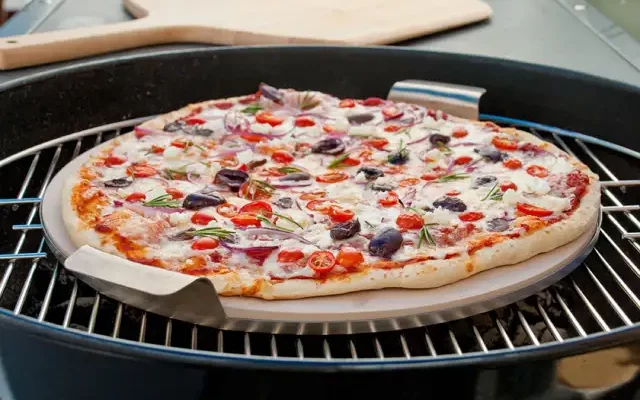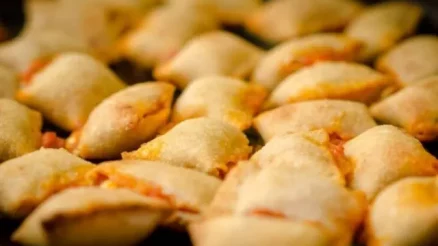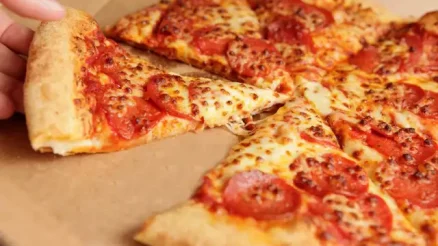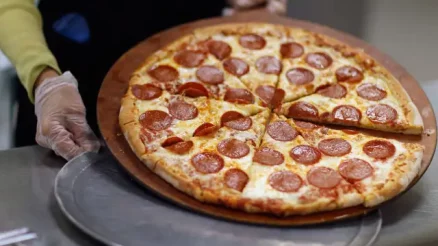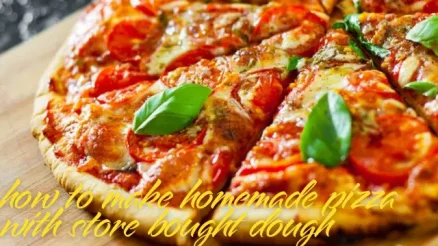If you are looking for how to use a pizza stone in the oven, look no further!
A pizza stone is a great tool to have in your kitchen, not only for making delicious pizzas but also for cooking other things. You can use it on its own, or you can use it with your oven. In this article, we will go over the different uses of a pizza stone and how to make sure that you get the most out of yours!
Contents
What is a pizza stone?
A pizza stone is a piece of ceramic cookware designed to distribute and retain heat evenly. It is mainly used for cooking pizzas, but it can also be utilized for baking bread and pastries and roasting meats and vegetables.
When you’re shopping for a stone, choose one made from natural materials such as ceramic or stone; avoid the cheaper artificial rocks that are not porous and tend to crack easily (low-quality rocks may also contain toxic chemicals).
Pizza stones come in different shapes and sizes: round ones work best for pizzas, while rectangular ones are often preferred for baking bread. If you want to make more than one type of food on your stone, we recommend purchasing several specialized pieces in addition to your stone.
What are the benefits of using a pizza stone?
Pizza stones are the best alternative to conventional metal baking pans because they can withstand extremely high temperatures without warping, unlike metal. They are also more durable than traditional stone cookware. What’s more, they distribute heat evenly and can be used with or without an oven (to bake pizzas).
A pizza stone is ideal for cooking pizzas because it absorbs moisture from the dough, ensuring that your crust will be crisp and delicious. Stone-baked pies retain their heat longer than those prepared in ovens so that you can enjoy them for much longer!
You can also use it to make bread and pastries; these will cook exceptionally well on a stone. If you love roasting meat and vegetables, a stone is also the best tool for you: it can keep hearts juicy while sealing in their natural juices, and it’s perfect for cracking open hard-skinned veggies such as squashes or potatoes!
If your oven does not have a particular baking stone, you can place an inverted cast iron pan on the bottom rack (leave the frame in the center of the oven) to achieve similar results.
You can also use ceramic or porcelain tiles instead of stone; tiles are even cheaper than stones, but they’re harder to handle safely (they break easily). So if you don’t mind buying several pieces, we recommend choosing stones over tiles (or cast iron pans).
What are the disadvantages of using a pizza stone?
The main disadvantage of using a pizza stone is that it must be used in your oven, so you can’t use your stone if you don’t have a range. Using stones in an oven requires special care: stones are fragile and may crack or break under very high heat conditions.
It would help if you never washed them with soap or put them in the dishwasher. Instead, brush away any debris with a dry pastry brush, rinse them well, and place them on a cooling rack to dry completely before storing.
Wet stones absorb moisture from the air, which eventually transfers to whatever you’re cooking, resulting in wet food!
How to clean a pizza stone?
To keep your stone in good shape, it is essential that you clean and maintain it properly. Follow this simple cleaning regimen:
Always remove the stone from your oven as soon as you’re done cooking and let it cool down. This will prevent any damage resulting from thermal shock (a rapid change in temperature, which can cause cracks or chips).
Once the stone has cooled down enough to be handled safely, use a dry pastry brush to remove any debris stuck on its surface. If something burnt on, sprinkle some coarse salt onto the spot and scrub with a wet sponge. You’ll easily remove all dirt this way! 😉
If necessary, you can also use warm water and an abrasive cleanser to remove stubborn material that the salt didn’t get. Be sure to rinse well and let your stone dry out completely before placing it back into your oven.
Once the stone is dry, brush away any leftover salt residue with a pastry brush, then rub some cooking oil onto its surface so it doesn’t crack or split. You can also use mineral oil for this purpose, but never vegetable oil because it may eventually go rancid.
How to use a pizza stone in the oven?
You can use your stone for cooking all types of dough, including pizza, flatbread, or focaccia.
1) If you have a gas oven with an electric broiler, be aware that the flames may come in contact with the stone and thus damage it.
Similarly, if your range has hot spots (these are particularly common with stovetops), you should place the stone on an oven rack on one of these spots to even out the heat distribution. Positioning it too close to the broiler will also cause problems because of excessive heat exposure.
2) Preheat your oven at 500°F. Once heated, reduce the temperature to 475°F before placing your pizza (or bread and pastries) onto your stone: this increases the cooking speed while minimizing side effects such as too brown or burnt edges.
3) As soon as you add the pizza to it, increase the temperature back to 500°F and bake for 12-15 minutes (or whatever is necessary for your particular recipe). Keep an eye on it during this time to make sure that nothing burns or gets stuck to your stone!
If anything does happen, don’t worry: scrape off whatever has solidified onto your stone with a wet sponge and continue baking. Be sure not to forget about it, though: burned bits will permanently damage your stone over time if left untreated.
4) After cooking, remove the pizza from the oven and let it sit for a couple of minutes before serving. Cutting it right away may cause the toppings to run off the sides and make a complete mess!
5) To store, place your stone on a cooling rack in an area with no direct sunlight. A linen or cotton cloth will also do, but never keep it inside an airtight container and other kitchen items. This will increase humidity levels which are bad for any porous material.
Tips for using your pizza stone
Add water to your dough by kneading in a couple of teaspoons of baking soda. This will give it some chewiness and make the extra crust crispy!
To achieve an extra crispy result, try placing your stone on an oven rack on high heat for 5 minutes after preheating.
If you want nicely charred bits around the edges (which can be delicious), place your baking sheet/pizza stone on top of the stove burner as soon as you’ve removed what’s been cooking from it. Just keep it there until they’re perfectly browned before serving!
A pizza stone is one of those inexpensive yet invaluable little tools that just about anyone can use to turn out pizzas at home. In addition to being easy to use, they’re relatively cheap and can last for years. Just follow our tips above on how to take care of it properly, and your stone will serve you well for many years!
What kind of pizza stone should you get?
The stones are made from quartzite, a combination of sand, soda ash, and limestone. A porous material with excellent thermal conductivity, you only need to preheat your stone, and it will evenly distribute the heat so that your pizza crusts get perfectly done on the outside while remaining fluffy and moist on the inside.
The whole brick has been heated at around 2000°F which forms its baking surface into one giant pizza stone. You can use this type for roasting poultry like chicken or turkey since they’re generally more significant than the traditional round stones.
However, remember that you should never cut directly onto them: sprinkle some cornmeal over the stone once it’s cooled down instead of using kitchen tools.
If you’re on a budget, these are the best choice. Go with a rectangle stone if you intend to make pizzas in the oven, and look for one that’s glazed (i.e., treated in a range at high temperature) because it will be much easier to clean and handle than unglazed stones.
For cooking pizzas and other food items directly on top of your stove, go with round stones shaped like disks that you place over the burner when it’s hot enough. They’re smaller than fixed stones but can still do a decent job without taking up too much space in your kitchen.
Repairing damaged pizza stones is not easy, so avoid buying them used if possible: they might have cracks or fissures that can’t be detected without scientific instruments.
You can also look for models with handles to make them easier to lift and move around the kitchen, but note that these are not oven-safe, so you will need to use baking sheets with them at all times.
Tips for cooking on your pizza stone
To prevent cheese from sticking to the surface of your stone, sprinkle some cornmeal over it after preheating before laying out your ingredients. The toppings won’t slide off so easily if they’re lightly covered in this! This is especially useful when using more moist ingredients such as ricotta or cooked vegetables.
Sprinkle flour over the top of your pizza dough right before you press it into a flat disk – let it sit for a few minutes until the flour is absorbed into the dough. Slap it back and forth a bit before adding your toppings to stretch it out as evenly as possible.
– Do not use any ingredients that are very acidic, such as tomato sauce or vinegar-based barbecue sauces, to avoid ruining your stone with all that excess acid! Only cook foods on your pizza stone that are oil-free because fat can leave stains behind even if you clean them carefully afterward.
To wash your stones properly, make sure to scrub them vigorously with soap and water immediately after cooking (while they’re still hot) so that no burnt bits become attached to their surfaces.
If you’ve used sugar in your recipe, sprinkle some lemon juice over them before bringing up the heat to allow them to dissolve and form a coating that’s easier to clean off.
Recipes for cooking pizzas on your new pizza stone
The options are endless!
Roll out your dough into a thin disk, sprinkle some cornmeal on top, and cook it at 350°F for about 5 minutes (keep an eye on the color change to ensure it doesn’t get too dark) or until slightly browned.
Sprinkle with garlic powder, oregano, and basil before adding your marinara sauce, veggies, and other toppings before baking at 500°F for 10 to 15 minutes.
For delicious crispy pizza rolls, place balls of dough one inch apart from each other directly onto the hot rock in your oven.
Bake them for five minutes or so before brushing them with olive oil and turning down the heat to 300°F while adding your marinara sauce, veggies, and other toppings. Bake for 5 to 10 minutes longer until the cheese is fully melted.
Cut your dough into small circles using a large biscuit cutter, sprinkle with cornmeal, lay them out on top of the stone in the oven, and bake at 375°F for 5 to 10 minutes or until light golden brown so that they stiffen up enough before adding your marinara sauce, veggies and other toppings.
Bake for another 6 to 8 minutes until crispy.
Cut pieces of pizza dough into long strips with kitchen shears, place them on top of the hot stone and cook at 375°F for about 3 to 5 minutes or until golden brown.
Flip them over onto the stone once they start to stiffen up if you’re using marinara sauce, veggies, and other toppings before cooking for another 4 to 6 minutes until crispy.
Place balls of dough directly onto your hot ungreased tile stone at 500°F. Cook for 10 to 15 minutes or until outer crust is crispy and lightly browned, flip them onto the rock if you’re using marinara sauce, veggies, and other toppings, then bake for another 6 to 8 minutes or until crispy.
Top each ball of dough with about a tablespoon of pizza sauce, pinch all around the top so that it forms deep ridges before baking at 375°F for 5 to 7 minutes or until golden brown so that they stiffen up enough before adding your marinara sauce, veggies, and other toppings.
Bake for another 4 to 5 minutes or until cheese has fully melted.
Recipes that are great with the help of a pizza stone (examples include breakfast pizzas, meatless pizzas, and more!)
Spread your dough into a circle and place it on top of your preheated pizza stone to cook at 400°F. Remove from the oven after about 5 minutes or until the crust starts to stiffen up, then flip over onto the rock if you’re using marinara sauce, veggies, and other toppings before cooking for another 4 to 6 minutes or until crispy.
Roll out your dough into an oval shape, spread with pesto (or tomato sauce if you prefer), and sprinkle with vegan cheese shreds before baking at 375°F for 10 minutes or until lightly browned so that they stiffen up enough before adding your marinara sauce, veggies, and other toppings.
Bake for 5 minutes (4 to 6 minutes if baking with marinara sauce, veggies, and other toppings) longer until the cheese has fully melted.
Spread your dough into a circle or shape it into a rectangle, then place it on top of preheated pizza stone at 400°F to cook for 5 to 7 minutes or until golden brown so that it stiffens up enough before adding your marinara sauce, veggies, and other toppings. Bake for another 4 to 6 minutes or until crispy.
FAQs about using a pizza stone
Do you put pizza directly on the pizza stone?
Most people put their marinara sauce, veggies, and other toppings on top of the pizza dough AFTER it has already been cooked. Still, if you’re trying to make a crispy crust, some say that putting the dough on top of your pizza stone (uncooked) helps create a crisper texture.
Can you wash a pizza stone?
You can place any food-safe soap on the stone then douse it with boiling water before scrubbing away any crusted bits with a nonmetal brush or sponge.
Does cooking pizzas on pizza stones make them healthier?
Not at all! If anything, you’ll likely end up consuming more calories because your baked goods will be more. Healthy baking alternatives include using whole grain flour, apple sauce instead of oil, and egg whites plus veggies for toppings (or making pizza without cheese.
How do you keep pizza from sticking to a pizza stone?
To prevent your pizza dough from sticking to the stone, place a sheet of parchment paper or aluminum foil on top, then bake. Slide it over to an edge with a thin spatula to remove the cooked item, then lift slowly.
How do you know if your oven is hot enough to use a pizza stone?
You should be able to hold your hand about 6 inches away from the heating element for 2 seconds before it becomes unbearably hot, so that means that around 25 seconds is all you need before adding your marinara sauce, veggies, and other toppings.
Remember, though, that 525°F isn’t high enough, so try 550°F instead by turning off the convection on some ovens. If it still isn’t hot enough, try placing a sheet of aluminum foil on top of the rack before preheating.
What is the best temperature for baking pizzas on a pizza stone?
The safest temperature to use should be around 425°F, but if you have a hotter oven, you can bake it at 450°F or 475°F.
The last resort would be to cook it at 500°F but remember that you should only do this for about 8 minutes or until lightly browned so that they stiffen up enough before adding your marinara sauce, veggies, and other toppings. Bake from 4 to 6 minutes longer until cheese has fully melted.
Do you have to do anything to a pizza stone before using it?
Yes! Make sure that you wash your pizza stone with soap and water, then dry it before preheating. You should also brush or spray the surface with oil (don’t use olive oil because it burns quickly).
What happens if you don’t preheat a pizza stone?
Your pizza will take twice as long to bake, so make sure you preheat the oven AND the stone for better results. If your dough is still cold after cooking on high heat, it could create a soggy crust.
Does pizza stone make pizza crispy?
As mentioned above, it can help create a crisper texture as long as you put your dough on top of the pizza stone (uncooked).
Do you have to use cornmeal on a pizza stone?
There is no need to use cornmeal on a pizza stone because the whole point of this kitchen tool is to distribute heat, not provide flavor evenly.
Which side is up on pizza stone?
Similar to which side is up on a frying pan, the answer depends on what you’re baking. If it’s bread, place it upside down so that the flattest surface is touching the surface of your oven.
In this case, flatbreads would be cooked right-side-up, and pizzas would be cooked upside down with toppings underneath for better flavor penetration.
Can you put a frozen pizza on a pizza stone?
Yes! Place it on a parchment paper-lined baking sheet, then transfer to a preheated oven. As for the stone, put it in the cold oven and turn it up to 425°F or 450°F since you won’t be cooking with high heat.
Do pizza stones need to be seasoned?
No! Your baking surface has already been seasoned by the manufacturer, so there’s no need to re-season it. Just wash with soap and water, then dry before baking.
Why does my pizza stick to the stone?
If your dough isn’t sticking, then it could be that you’re using too much sauce, cheese, or toppings. If you have a thin crust pizza, it might be due to not cooking your dough long enough before adding the toppings.
Final thoughts on how to use a pizza stone
Remember, properly preheating your oven, and the pizza stone is crucial so that they have ample time to get hot. That being said, it’s not recommended for gas ovens since there are no vents near the bottom where you place your baking sheet.
If you use a metal utensil, it could damage your stone, so always use wooden or plastic ones instead.
Also, keep in mind that no seasoning can make up for highly porous stones, so consider buying one with rolled edges for safety reasons (example: uni elemental Pizza Stone ). Wooden handles should also be oven-safe but if you’re unsure about yours, check the manufacturer’s website before using this item in the kitchen.


